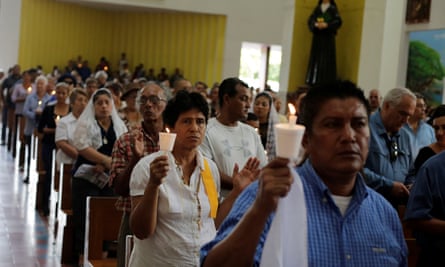As mass concluded in Managua’s Metropolitan Cathedral, chants of “Liberty!” and “Justice!” broke out among the congregation. Outside, protesters unfurled a giant Nicaraguan flag – a prohibited symbol of the country’s recent uprising – from the building’s roof.
Blue and white balloons rose into the sky as demonstrators in the church grounds planted wooden crosses – each inscribed with the name of someone killed in the past six months of rebellion and repression.
Protest is outlawed in Nicaragua, as President Daniel Ortega seeks to stamp out any trace of the civil revolt that threatened to bring down his government earlier this year.
Street demonstrations are brutally quashed. More than 550 protesters languish in jail. Human rights groups have documented widespread use of torture.
Facing such repression, protesters have retreated to the one place where police and paramilitary forces won’t pursue them.
“The church has become the last space where citizens can freely express themselves, and demand their rights,” said lawyer Martha Molina.

The Catholic church has provided sanctuary since the earliest days of the crisis, in which hundreds have been killed.
Protests began in April, triggered by welfare cuts but rooted in deeper anger over Ortega’s growing authoritarianism.
On 21 April, with the death toll already climbing, bishops rescued students besieged by police and militants in the Metropolitan Cathedral. “I want to thank you in the name of the church, because you are our country’s moral reserve,” the auxiliary bishop of Managua, Silvio Báez, told them.
As the uprising spread, Nicaragua’s Episcopal Conference persuaded Ortega to let it mediate talks. But negotiations repeatedly collapsed. In July – after a church harbouring students was riddled with gunfire – bishops accused state representatives of “distorting” the process.
Days later, on the 39th anniversary of the Sandinista revolution, Ortega turned on the church. “The bishops are committed to the coup-mongers,” the former guerrilla leader told supporters, accusing clerics of stockpiling weapons.
This rhetorical assault marked the end of Ortega’s efforts to maintain ties with the church, an alliance that was key to his return to power in 2007.
In 2006, as elections approached, the one-time revolutionary rebranded himself a reverent Catholic. Weeks before the vote, legislation imposing a total ban on abortion passed the national assembly – thanks to the unanimous support of Ortega’s FSLN delegates.
Now, however, Ortega has turned on his former allies. “The bishops have been extraordinary in defence of human rights, and the government wants to silence that voice,” said Ana Margarita Vigil, a prominent feminist and opposition activist.
The most virulent abuse has been directed at Báez, who studied scripture in Rome for 30 years before returning to Nicaragua in 2009. His arrival reoriented the church towards a more critical stance, culminating in a prescient letter, published in 2014, warning that the erosion of democracy endangered Nicaragua’s future “in a very alarming way”.
“Báez is an intellectual, the most qualified bishop in Nicaragua,” said Israel González, the Nicaragua correspondent for Catholic news service Religión Digital. “His return was a measure taken to strengthen the church, at a time when an authoritarian government was appropriating the symbolic force of Catholic piety for its own ends.”

At the end of October, state media targeted Báez with fresh accusations. Secret recordings purported to catch him plotting against the government. Reports described him as a “terrorist” and “fascist”, insisting he should “leave Nicaragua”.
Báez – already granted protective measures by the Inter-American Commission on Human Rights – dismissed the recordings as “manipulated”. (Independent analysis supports this.) But the smear campaign was followed by a barrage of death threats.
The threats carried particular resonance, coming just days after the canonisation of the Salvadoran archbishop Óscar Romero, gunned down while celebrating mass in a hospital chapel in 1980 for speaking out against the country’s dictatorship.
The assault on the church has had an effect. Báez has lowered his profile, giving his homilies in a secluded seminary on the outskirts of Managua – though he continues to condemn the “disgrace” of authoritarian power, and told the Guardian he would stay in Nicaragua.
In the Metropolitan Cathedral, too, priests have sought to pull back from the frontline of the crisis. During a recent Sunday mass, the church’s rector, Luis Herrera, told worshippers: “temples are for praying, not protesting”.
But protesters – many of whom have seen friends and relatives killed or jailed by Ortega’s forces – are reluctant to comply.
“We have to raise our voices for justice for those killed and freedom for the hundreds in prison,” said Karla Villalta, 49, standing among the wooden crosses. “The revolution was something beautiful, but Ortega and his wife have buried it.”
